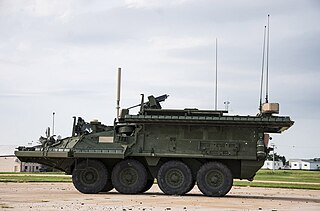Related Research Articles

The High Mobility Multipurpose Wheeled Vehicle is a family of light, four-wheel drive military trucks and utility vehicles produced by AM General. It has largely supplanted the roles previously performed by the original jeep, and others such as the Vietnam War-era M151 Jeep, the M561 "Gama Goat", their M718A1 and M792 ambulance versions, the Commercial Utility Cargo Vehicle, and other light trucks. Primarily used by the United States military, it is also used by numerous other countries and organizations and even in civilian adaptations.

The Stryker is a family of eight-wheeled armored fighting vehicles derived from the Canadian LAV III. Stryker vehicles are produced by General Dynamics Land Systems-Canada (GDLS-C) for the United States Army in a plant in London, Ontario. It has four-wheel drive (8×4) and can be switched to all-wheel drive (8×8).

Insurgency weapons and tactics (IWAT) are weapons and tactics, most often involving firearms or explosive devices, intended for use by insurgents to engage in guerrilla warfare against an occupier, or for use by rebels against an established government. One type of insurgency weapon are "homemade" firearms made by non-professionals, such as the Błyskawica (Lightning) submachine gun produced in underground workshops by the Polish resistance movement. One weapon that is part of the conventional military arsenal but which has been taken up to great effect by insurgents, is the RPG. Two examples of an improvised weapon used by insurgents would be the improvised explosive devices used in Iraq and the Molotov cocktails used against vehicles and tanks. Two tactics used by many insurgents are assassinations and suicide bomb attacks. The latter tactic is used when an insurgent has a bomb strapped to them or in their car, which provides a low-tech way for insurgents to get explosives close to critical enemy targets.

A gun truck is an armored vehicle with one or more crew-served weapons, typically based on a military truck. Gun trucks often have improvised vehicle armor, such as scrap metal, concrete, gravel, or sandbags, which is added to a heavy truck.

The armoured bulldozer is a basic tool of combat engineering. These combat engineering vehicles combine the earth moving capabilities of the bulldozer with armour which protects the vehicle and its operator in or near combat. Most are civilian bulldozers modified by addition of vehicle armour/military equipment, but some are tanks stripped of armament and fitted with a dozer blade. Some tanks have bulldozer blades while retaining their armament, but this does not make them armoured bulldozers as such, because combat remains the primary role—earth moving is a secondary task.

The Cougar is a mine-resistant ambush-protected (MRAP) and infantry mobility vehicle structured to be resistant to landmines and improvised munitions.

The M1117 armored security vehicle is an internal security vehicle based on the V-100 and V-150 Commando series of armored cars. It was developed in the late 1990s for service with the United States' Military Police Corps. The first prototypes appeared in February 1997 and serial production of the M1117 commenced between 1999 and early 2000.

An infantry mobility vehicle (IMV) is a four-wheel drive armored personnel carrier (APC) serving as a armed military transport, military patrol, reconnaissance or security vehicle. Examples include the ATF Dingo, Otokar Cobra II, Iveco LMV, Oshkosh M-ATV, AMZ Dzik, AMZ Tur, Mungo ESK, and Bushmaster IMV. Most modern infantry mobility vehicles have certain level of Mine-Resistant Ambush Protected (MRAP) capabilities. The physical appearance of the Infantry mobility vehicles are generally similar to the SUV, covered Pickup truck or Box truck.

Slat armor, also known as bar armor, cage armor, and standoff armor, is a type of vehicle armor designed to protect against high-explosive anti-tank (HEAT) attacks, as used by anti-tank guided missiles (ATGMs) and rocket-propelled grenades (RPGs).

Improvised vehicle armour is a form of vehicle armour consisting of protective materials added to a vehicle such as a car, truck, or tank in an irregular and extemporized fashion using available materials. Typically, improvised armour is added in the field and it was not originally part of the design, an official up-armour kit, nor centrally planned and distributed. Improvised armour is used to protect occupants from small arms, crew-served weapons, artillery fire, and mines. Improvised additions have included metal plate, scrap metal, sandbags, concrete, wood, and, since at least the 2000s, Kevlar. These materials vary widely in their ballistic protection.

Frag Kit 6 is a vehicular armor upgrade kit developed by the U.S. Army Research Laboratory to defeat explosively formed projectiles (EFP), a type of armor penetrator often utilized in improvised explosive devices (IED). It is designed to be added on armored vehicles such as the MRAP and unarmored Humvee. Like the Chobham armor, the exact materials and the way it works is classified information.

The Force Protection Ocelot is a British infantry mobility vehicle that replaced the United Kingdom's Snatch Land Rover with British forces. It received the service name Foxhound, in line with the canine names given to other wheeled armored vehicles in current British use such as Mastiff, Wolfhound, and Ridgeback, which are all variants of the Cougar.

The Ground Mobility Vehicle (GMV) is a U.S. Special Operations Command, (US)SOCOM program, initially modifying Humvees into several variants for use by the United States special operations forces (SOF).

The Q-NET is an add-on armor kit developed by QinetiQ to counter the threat of rocket-propelled grenades.

Iron Curtain was an active protection system (APS) created in 2005 and designed by Artis, an American technology development and manufacturing firm. The system deactivated threats, such as rocket-propelled grenades (RPG) and other shoulder-launched missiles.

Counter-IED equipment are created primarily for military and law enforcement. They are used for standoff detection of explosives and explosive precursor components and defeating the Improvised Explosive Devices (IEDs) devices themselves as part of a broader counter-terrorism, counter-insurgency, or law enforcement effort.
The Rhino Passive Infrared Defeat System was an early detonation Counter-IED system. It was mounted to the front of a vehicle and used heat to prematurely detonate any hidden improvised explosive devices (IEDs) while the vehicle was at a safe distance away from the blast. It was developed by the Joint Improvised-Threat Defeat Organization (JIEDDO) in 2006 during the war in Iraq to counter the rise of IED-related deaths.
The M1114 HMMWV Interim Fragment (Frag) Kit 5 was an add-on armor for doors of the M1114 HMMWV. It consisted of four bolt-on doors that provided another layer of metal over the previously established factory-built armor, and was initially deployed in the field in April 2006. The doors provided another layer of metal over the previously established factory-built armor. This kit was designed and tested by the U.S. Army Research Laboratory at Aberdeen Proving Ground, MD.
The Improvised Explosive Device Countermeasure Equipment (ICE) is a vehicle-mounted electronics-based jamming system that uses low-power radio frequency energy to thwart enemy improvised explosive devices (IEDs). The radio frequency energy it emits blocks the signals broadcast by radio-controlled detonators, such as cell phones and cordless telephones, that would otherwise trigger the hidden IED to explode. ICE was developed by the Army Research Laboratory (ARL) at White Sands Missile Range and the Physical Science Laboratory (PSL) at New Mexico State University in 2004 to counter the rising IED threat in Iraq. Due to the urgent demand for counter-IED equipment, ICE was designed and built within three weeks and was provided to troops in less than six months after the project started.

United States MRAP program was created to produce Mine-Resistant Ambush Protected Vehicle for the country. In 2004, the TSG/FPI Cougar was designed by a British-led U.S. team, to U.S. Marine Corps requirements. It became the springboard from which the MRAP program was launched. Only two "armor quality" steel mills operate in the U.S.: the Russian-owned Oregon Steel Mills and the International Steel Group. The U.S. Department of Defense negotiated to ensure enough steel was available to keep pace with production. The U.S. military's MRAP program was prompted by U.S. casualties from improvised explosive devices (IED)s during the Iraq War. The United States Department of Defense MRAP program began in 2007 as a response to the increased threat of IEDs during the Iraq War. From 2007 until 2012, the MRAP program deployed more than 12,000 vehicles in the Iraq War and War in Afghanistan.
References
- 1 2 Pike, John. "Armor Survivability Kit (ASK)" . Retrieved 2018-06-19.
- 1 2 Green, Michael (2005). Humvee at War. Zenith Press. pp. 57–61. ISBN 0760321515.
- ↑ "Ad-Hoc Armor OK, but Check if it Meets Needs". www.defense-aerospace.com. Retrieved 2018-06-19.
- ↑ "Hard Work, Pride at Factory Making Humvee Armor". NPR.org. Retrieved 2018-06-19.
- 1 2 3 Moss, Michael (June 26, 2005). "Safer Vehicles for Soldiers: A Tale of Delays and Glitches". The New York Times.
- 1 2 3 4 Gibson, T'Jae (April 18, 2013). "Out on a limb" (PDF). APG News. Retrieved June 19, 2018.
- 1 2 Yap, Chun (September 2012). "The Impact of Armor on the Design, Utilization and Survivability of Ground Vehicles: The History of Armor Development and Use". Naval Postgraduate School: 23. Archived from the original on June 11, 2017 – via Defense Technical Information Center.
- 1 2 "Troops add improvised armor to Humvees". Stars and Stripes. Retrieved 2018-06-19.
- ↑ Schmitt, Eric (December 8, 2004). "Iraq-Bound Troops Confront Rumsfeld Over Lack of Armor". New York Times.
- 1 2 Moss, Michael (March 7, 2005). "Many Missteps Tied to Delay in Armor for Troops in Iraq". New York Times.
- 1 2 Russell, Robery (June 12, 2009). "Does the MRAP Meet the US Army's Needs as the Primary Method of Protecting Troops from the IED Threat?". Army Command and General Staff. Archived from the original on November 15, 2011 – via Defense Technical Information Center.
- ↑ "Artifacts as "Snapshots in Time" - The Campaign for the National Museum of the United States Army". The Campaign for the National Museum of the United States Army. 2014-12-29. Retrieved 2018-06-19.
- ↑ "Armor on Iraq Humvees Is Linked to Deadly Rollovers". Washington Post. 2006-06-12. ISSN 0190-8286 . Retrieved 2018-06-19.